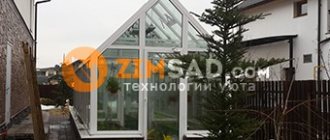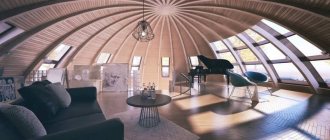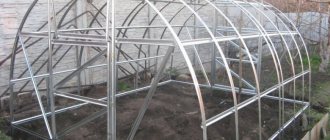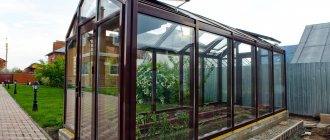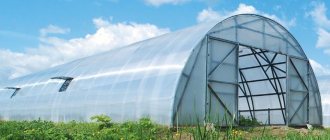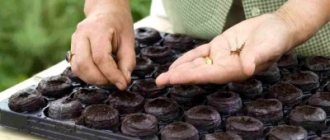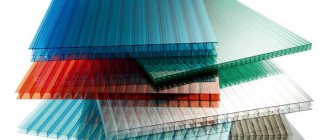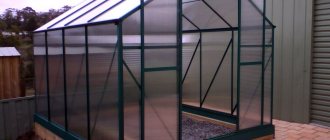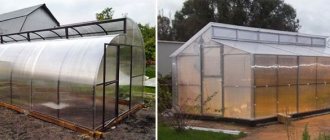Growing heat-loving vegetables in the middle zone - tomatoes, peppers, eggplants, cucumbers, melons - is much easier if you have a good greenhouse. The plants in it are protected from frost, rain and wind, the crop ripens faster, and you can work with the plants in any weather.
A small greenhouse is good, but a large one is even better. Due to lack of space in the greenhouse, we sometimes thicken plantings, which are then difficult to care for. In addition, poor air circulation leads to the development of various diseases. Therefore, it is better to immediately install a large greenhouse, if the area of the plot allows.
What are the main advantages of a spacious greenhouse?
- Large internal space and wide doors allow you to work in the greenhouse using a walk-behind tractor or a motor-cultivator.
- The height of the greenhouse allows you to plant tomatoes with unlimited growth and harvest until late autumn.
- The larger the greenhouse, the more comfortable the microclimate is: heated air moves upward, and the plants do not overheat.
In this article we will look at installing a greenhouse measuring 5x12 m. The height of our structure is 3 m.
Arrangement of seedlings
We take the seedlings and arrange them so that all the plants get the light and the leaves of the seedlings do not intertwine or even touch. This is necessary to provide light and warmth. This will be the best care.
The plant is growing and needs to be planted in time in the main soil - greenhouse soil from the container, because the stems can stretch out enough and even 2-3 fruits will form on one cluster, and the plant itself will spend entirely on the formation of these particular fruits. We constantly remove small stepsons. The upper stepson can be left; it forms a second stem located next to the flower stem.
When transporting to the dacha, so that the plants do not break and feel comfortable, try not to water the seedlings a few days before transportation; it is better to dry them, the stems will not be brittle and the plant will better tolerate a stressful situation.
From the middle or end of May, you can safely begin planting tomato seedlings in a film greenhouse or greenhouse. If you have a warm greenhouse, heated, and if you have a warm heated bed, using biofuel, based on plant residues, then you can start planting tomatoes in early May. It all depends on the specific greenhouse and weather conditions.
A prerequisite for good production and good fruiting is that soil and bed preparation must be carried out immediately before planting tomato seedlings. We dig up the ridge, loosen it, level it with a rake, then you need to add mineral fertilizers so that fruiting is abundant and good.
Preparing the base
Do you need a foundation for a greenhouse? Why not put it directly on the ground? Such questions often arise before installing a greenhouse. Greenhouses usually come with special T-shaped legs - lugs - about 30 cm long. If you use only these legs and install the structure directly on the ground, the service life of the greenhouse will be significantly reduced. Over time, the soil may shrink, which will lead to the frame being skewed. Doors will become difficult to open and cracks will appear. The bottom edges of the polycarbonate sheets in contact with the ground will be destroyed, insects and dirt will get into the honeycombs.
If your site is relatively flat, a small greenhouse can be placed on a timber base by attaching grousers to it. Such a base can be made quickly and inexpensively.
However, for a stationary greenhouse with a length of 10-12 m or more, this option is not suitable. Firstly, the timber can compensate for a very small difference in height on the site (no more than 20 cm), and secondly, no matter how you process the tree, it will still rot sooner or later while in the ground. Therefore, if you decide to install a large greenhouse, then you cannot do without a solid foundation.
The foundation is poured to the depth of soil freezing. In the middle zone it is about 120 cm. You can pour a strip foundation to this depth, but it’s easier and cheaper to make a pile-strip foundation.
We dig a trench under the foundation, pour or install piles. Then we construct the formwork, treating it from the inside with bitumen mastic.
The base of the pile must be below the freezing depth of the soil.
We pour sand into the bottom of the trench, spill it with water and fill the formwork with concrete. To ensure the strength of the foundation, we lay several rows of overlapping reinforcement. It is advisable to fill the tape without interruption, at a time, and remove air bubbles during work: compact the concrete using a construction vibrator or bayonet it with a shovel.
If the weather is sunny outside, we cover the foundation with oilcloth: the concrete must not dry out. The next day, water it with water and cover it again. Concrete gains initial strength within a week. After this, you can remove the formwork.
- How to make a foundation for a large greenhouse
Have you decided to install a greenhouse? We will show you how to create a strong and reliable foundation - a foundation.
Greenhouse shape
Polycarbonate greenhouses are manufactured in several standard configurations. They are single-pitch, gable, arched and teardrop-shaped.
Single-pitch
A structure with a pitched roof can be either free-standing or wall-mounted. The wall option is ideal for small areas. The advantages of such a greenhouse:
- good thermal insulation;
- economical consumption of materials;
- ease of installation.
There are also obvious disadvantages:
- the wall of the house does not allow the greenhouse to fully warm up;
- the structure may be damaged by snow or ice falling from the roof of the house.
Polycarbonate lean-to greenhouse Source vi.decorexpro.com
Gable
A design reminiscent of a classic house. Suitable in cases where you need to build a polycarbonate greenhouse whose dimensions are larger than average. Has the following advantages:
- maximum usable area;
- allows you to grow tall plants;
- good light transmission;
- simplicity in the arrangement of the ventilation system.
Minuses:
- increased consumption of materials, which is reflected in the final cost of the structure;
- it is necessary to ensure that sealing is maintained at the junction of the slopes and walls.
Gable greenhouse made of polycarbonate Source sbgreenhouse.com
Arched
The most practical form. There is no joint between the walls and the roof part, and at the same time, the arc-shaped configuration contributes to the rapid and effective removal of sediment.
Advantages:
- an arched building can be of any size, since it is easy to assemble a frame to fit any dimensions;
- high resistance to wind load;
- mobility - it can be easily dismantled and installed in another place;
- low consumption of materials.
Disadvantages:
- not suitable for growing tall crops;
- it is difficult to arrange ventilation.
Arched polycarbonate greenhouse Source stroyportal.ru
teardrop-shaped
Drop-shaped greenhouses have the most aesthetic design. They combine the characteristics of an arched and gable structure.
Advantages:
- increased strength;
- precipitation drains well from the surface of the structure;
- high light transmittance.
Flaws:
- difficulty of assembly;
- high price.
There are also more original forms of such structures. For example, you can build a mini-greenhouse with an opening top in the form of a breadbox or a round domed greenhouse. The choice depends on the requirements for the design. The most practical options are gable and arched shapes.
Drop-shaped greenhouse made of polycarbonate Source ro.decorexpro.com
Installation of polycarbonate
When cutting and installing polycarbonate sheets, it is important to follow the manufacturer's instructions. After cutting the material, we close the edges of the sheets with an end closing profile. This will help protect cellular channels from insects, dirt and dust. To ensure natural drainage of condensate and prevent the formation of mold, we drill small holes every 8-10 cm along the entire length of the plastic end profile.
For greenhouses, as a rule, cellular polycarbonate is used with a protective UV-stabilizing layer applied to the outer surface of the sheet. The protective film on this side has a special marking. To avoid mistakes, the film must be removed immediately before installation.
The upper edge of the polycarbonate end sheet can be covered with perforated tape. Since we didn’t have one, we covered the cellular channels with a narrow strip of spunbond, gluing it to double-sided tape.
We tried to install the polycarbonate in such a way that its lower edge rests on the foundation. This allows you to close the cracks and protect the foundation from the constant ingress of water flowing from the greenhouse.
We fixed the polycarbonate in the upper part of the greenhouse according to the instructions using tension tapes and self-tapping screws.
Types of complexes for professional growing of plants
The size and type of industrial greenhouse is determined by the needs of the farm and the financial capabilities of the investor. A modern greenhouse structure consists of several blocks with their own microclimate maintenance systems. Individual conditions are created for each type of plant in such a module to ensure maximum yield.
Farmhouse arched greenhouse
Depending on the operating conditions, such structures are divided into two types:
- Year-round.
- Seasonal (spring-autumn).
Drainage, heating, watering, lighting and ventilation systems are required.
Construction of industrial greenhouses is carried out in the following areas:
- with fertile soil;
- having clean water sources;
- with minimal slope;
- protected from the north side from the wind by trees or buildings.
On the one hand, a high greenhouse must be erected in a small depression, and on the other hand, the groundwater in this place must be deep enough so as not to have a harmful effect on the microclimate and the plants inside.
Important! Large greenhouses have a high windage capacity. They should be installed in areas protected from the wind, so that there is no space left between the ground and the base of the structure
Structurally, industrial greenhouses are arched, pointed, single- and double-sloped, straight, block or hangar. The frame is made of metal structures, wood or plastic. And polyethylene, polycarbonate or glass are used as covering materials.
Scheme of a lancet-type farm greenhouse
According to cultivation technology, they are divided into five types:
- Soil (ground).
- Shelving.
- Sub-irrigation.
- Hydroponic.
- Mixed.
There are many methods for indoor cultivation of fruit and vegetable plants, and new ones are constantly appearing. Designers are forced to follow the innovations of agricultural technologies and regularly update the list of modifications. But in most situations, the construction of industrial greenhouses requires an individual approach. Before choosing the type of construction, many nuances are analyzed, and only then the design of the original greenhouse begins.
Assembling the frame of an industrial greenhouse
